Abstract
It has been proposed that endogenous hexokinases of the pancreatic beta cell control the rate of glucose-stimulated insulin secretion and that genetic defects that reduce beta-cell hexokinase activity may lead to diabetes. To test these hypotheses, we have produced transgenic mice that have a 2-fold increase in hexokinase activity specific to the pancreatic beta cell. This increase was sufficient to significantly augment glucose-stimulated insulin secretion of isolated pancreatic islets, increase serum insulin levels in vivo, and lower the blood glucose levels of transgenic mice by 20-50% below control levels. Elevation of hexokinase activity also significantly reduced blood glucose levels of diabetic mice. These results confirm the role of beta-cell hexokinase activity in the regulation of insulin secretion and glucose homeostasis. They also provide strong support for the proposal that reductions in beta-cell hexokinase activity can produce diabetes.
Full text
PDF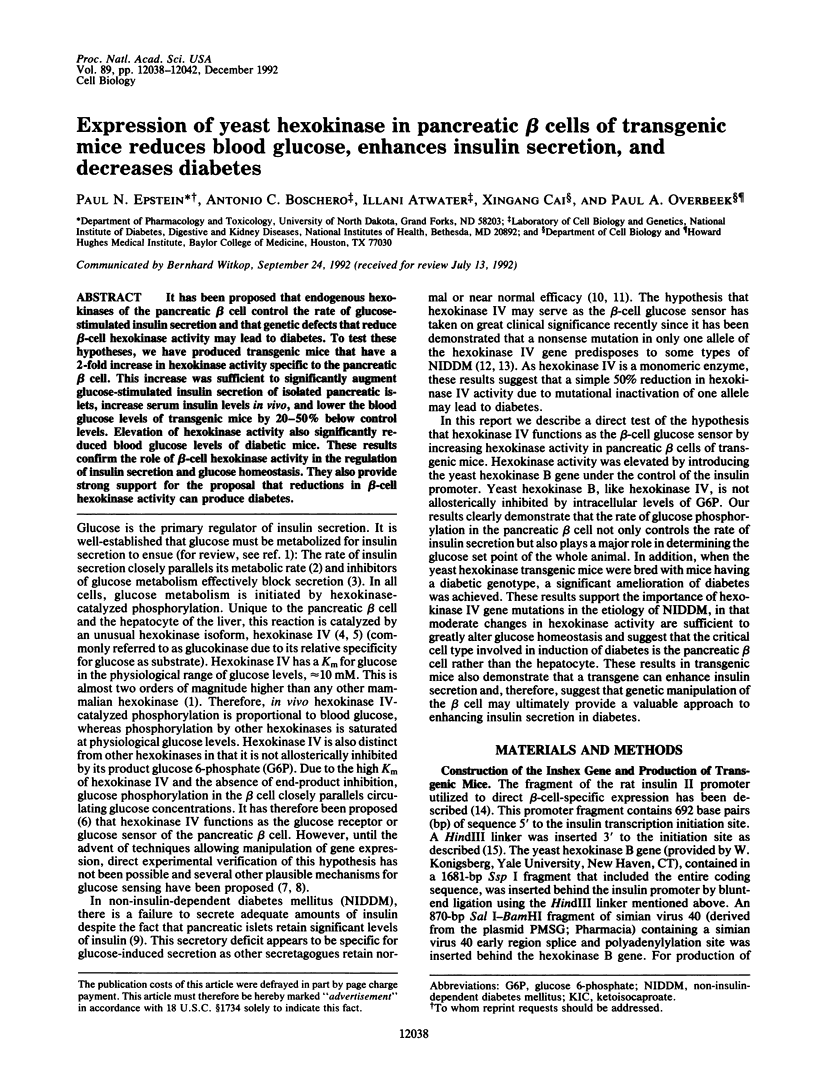
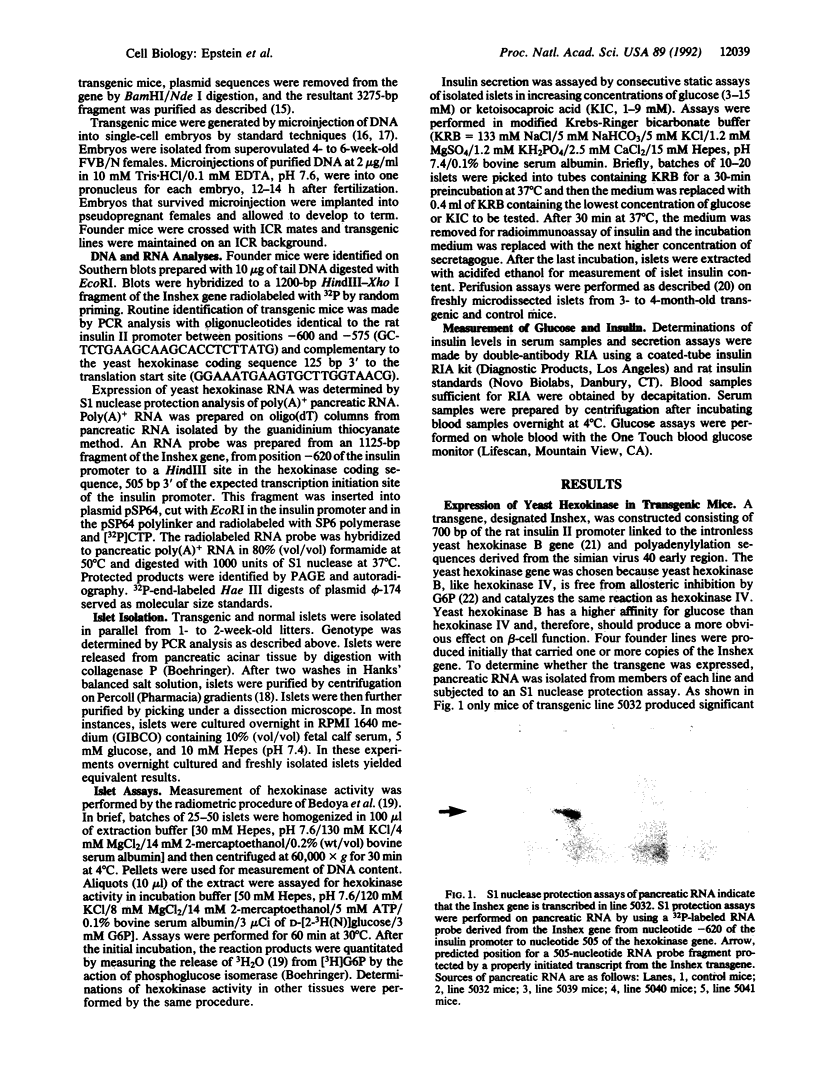
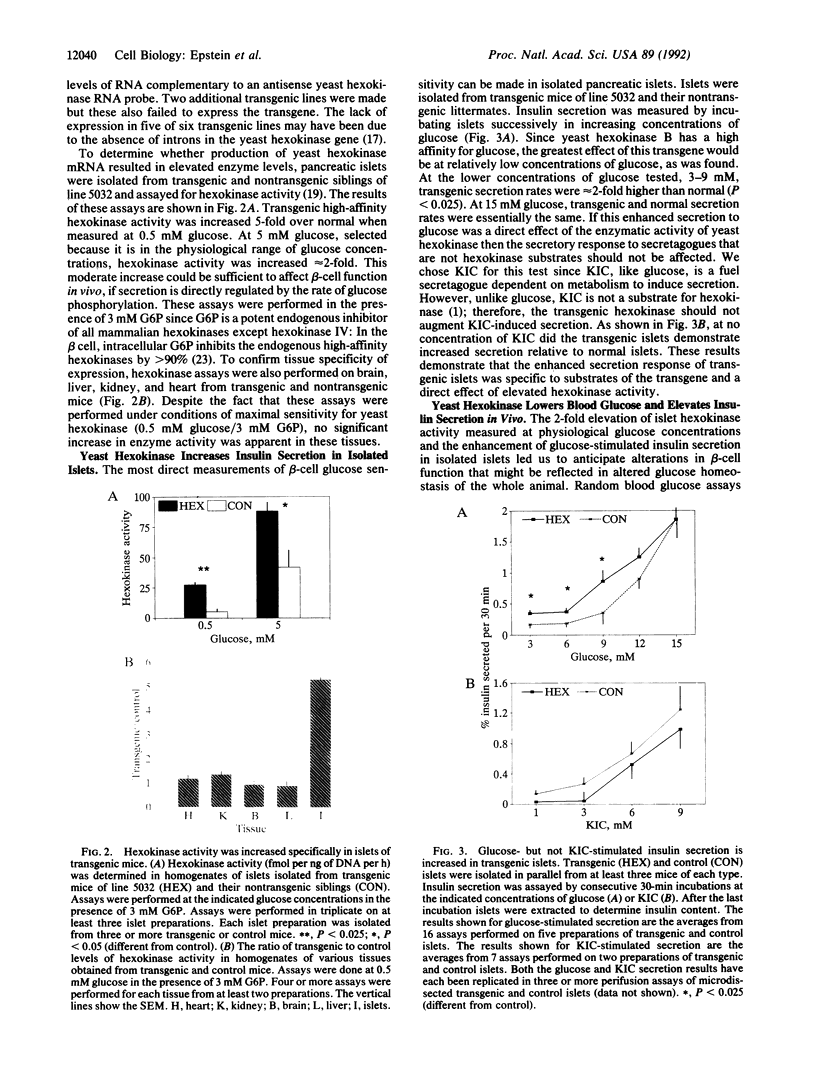
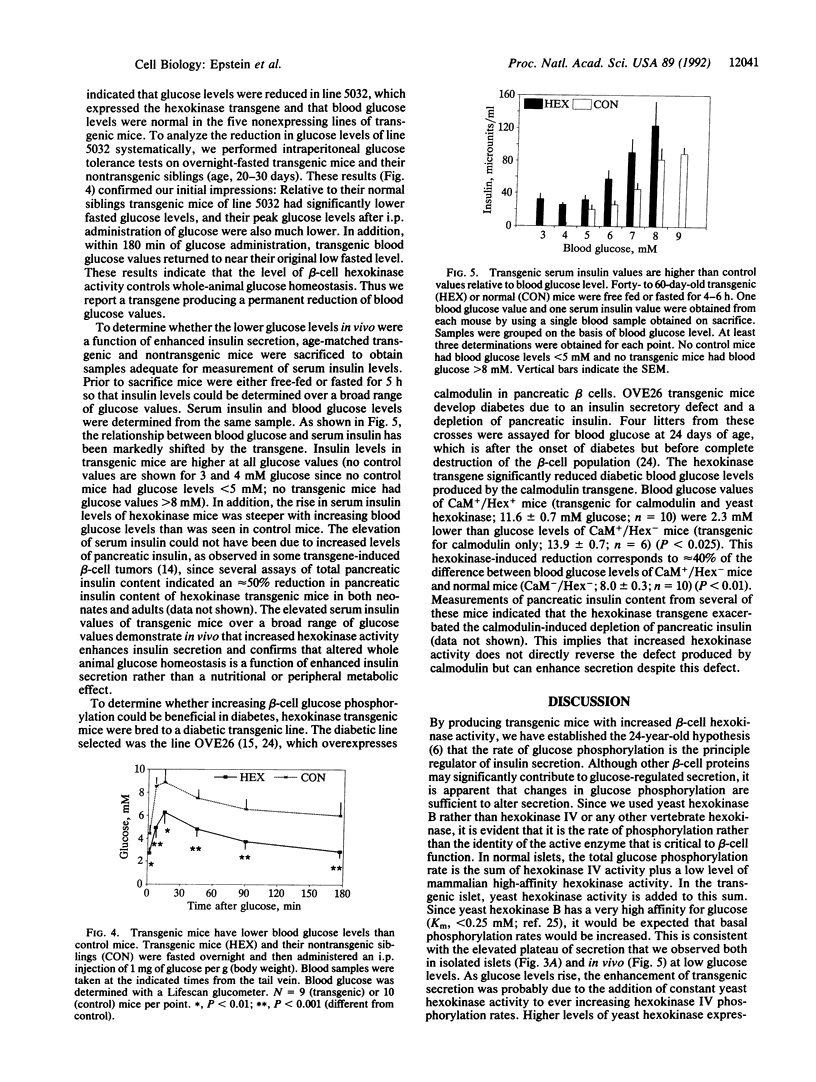
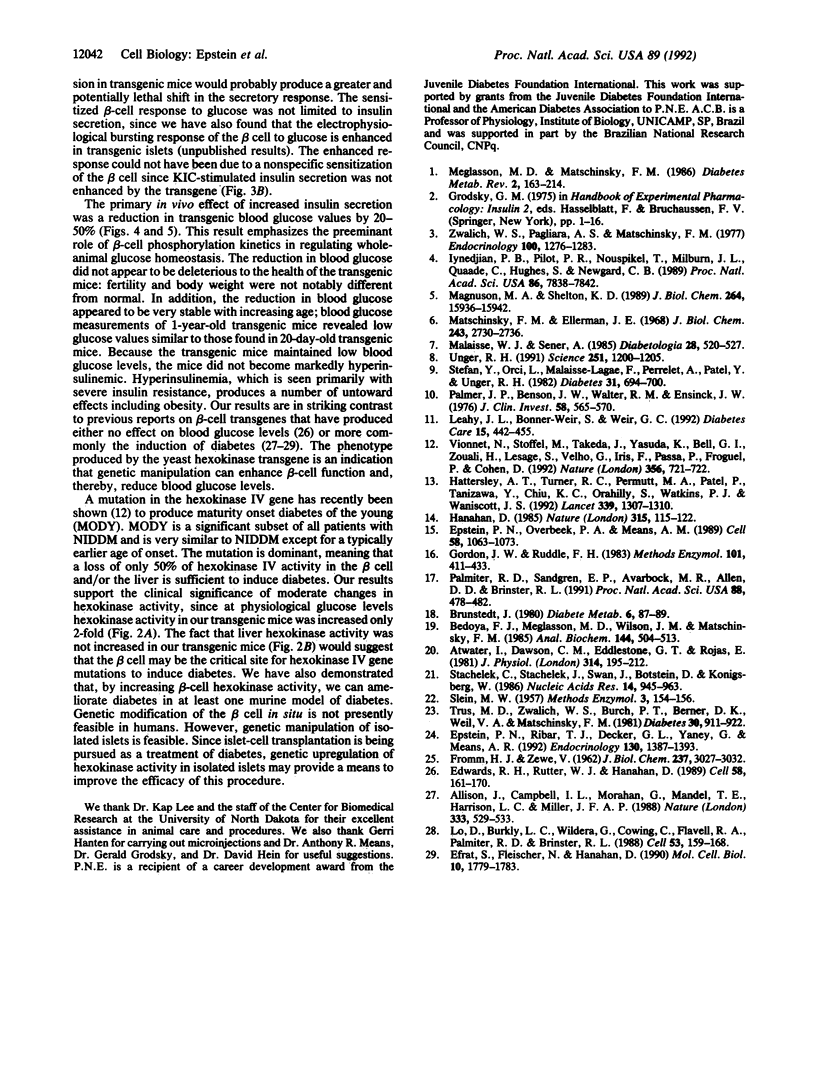
Images in this article
Selected References
These references are in PubMed. This may not be the complete list of references from this article.
- Allison J., Campbell I. L., Morahan G., Mandel T. E., Harrison L. C., Miller J. F. Diabetes in transgenic mice resulting from over-expression of class I histocompatibility molecules in pancreatic beta cells. Nature. 1988 Jun 9;333(6173):529–533. doi: 10.1038/333529a0. [DOI] [PubMed] [Google Scholar]
- Atwater I., Dawson C. M., Eddlestone G. T., Rojas E. Voltage noise measurements across the pancreatic beta-cell membrane: calcium channel characteristics. J Physiol. 1981 May;314:195–212. doi: 10.1113/jphysiol.1981.sp013701. [DOI] [PMC free article] [PubMed] [Google Scholar]
- Bedoya F. J., Meglasson M. D., Wilson J. M., Matschinsky F. M. Radiometric oil well assay for glucokinase in microscopic structures. Anal Biochem. 1985 Feb 1;144(2):504–513. doi: 10.1016/0003-2697(85)90147-2. [DOI] [PubMed] [Google Scholar]
- Brunstedt J. Rapid isolation of functionally intact pancreatic islets from mice and rats by percollTM gradient centrifucation. Diabete Metab. 1980 Jun;6(2):87–89. [PubMed] [Google Scholar]
- Edwards R. H., Rutter W. J., Hanahan D. Directed expression of NGF to pancreatic beta cells in transgenic mice leads to selective hyperinnervation of the islets. Cell. 1989 Jul 14;58(1):161–170. doi: 10.1016/0092-8674(89)90412-1. [DOI] [PubMed] [Google Scholar]
- Efrat S., Fleischer N., Hanahan D. Diabetes induced in male transgenic mice by expression of human H-ras oncoprotein in pancreatic beta cells. Mol Cell Biol. 1990 Apr;10(4):1779–1783. doi: 10.1128/mcb.10.4.1779. [DOI] [PMC free article] [PubMed] [Google Scholar]
- Epstein P. N., Overbeek P. A., Means A. R. Calmodulin-induced early-onset diabetes in transgenic mice. Cell. 1989 Sep 22;58(6):1067–1073. doi: 10.1016/0092-8674(89)90505-9. [DOI] [PubMed] [Google Scholar]
- Epstein P. N., Ribar T. J., Decker G. L., Yaney G., Means A. R. Elevated beta-cell calmodulin produces a unique insulin secretory defect in transgenic mice. Endocrinology. 1992 Mar;130(3):1387–1393. doi: 10.1210/endo.130.3.1371447. [DOI] [PubMed] [Google Scholar]
- Gordon J. W., Ruddle F. H. Gene transfer into mouse embryos: production of transgenic mice by pronuclear injection. Methods Enzymol. 1983;101:411–433. doi: 10.1016/0076-6879(83)01031-9. [DOI] [PubMed] [Google Scholar]
- Hanahan D. Heritable formation of pancreatic beta-cell tumours in transgenic mice expressing recombinant insulin/simian virus 40 oncogenes. Nature. 1985 May 9;315(6015):115–122. doi: 10.1038/315115a0. [DOI] [PubMed] [Google Scholar]
- Hattersley A. T., Turner R. C., Permutt M. A., Patel P., Tanizawa Y., Chiu K. C., O'Rahilly S., Watkins P. J., Wainscoat J. S. Linkage of type 2 diabetes to the glucokinase gene. Lancet. 1992 May 30;339(8805):1307–1310. doi: 10.1016/0140-6736(92)91958-b. [DOI] [PubMed] [Google Scholar]
- Iynedjian P. B., Pilot P. R., Nouspikel T., Milburn J. L., Quaade C., Hughes S., Ucla C., Newgard C. B. Differential expression and regulation of the glucokinase gene in liver and islets of Langerhans. Proc Natl Acad Sci U S A. 1989 Oct;86(20):7838–7842. doi: 10.1073/pnas.86.20.7838. [DOI] [PMC free article] [PubMed] [Google Scholar]
- Leahy J. L., Bonner-Weir S., Weir G. C. Beta-cell dysfunction induced by chronic hyperglycemia. Current ideas on mechanism of impaired glucose-induced insulin secretion. Diabetes Care. 1992 Mar;15(3):442–455. doi: 10.2337/diacare.15.3.442. [DOI] [PubMed] [Google Scholar]
- Lo D., Burkly L. C., Widera G., Cowing C., Flavell R. A., Palmiter R. D., Brinster R. L. Diabetes and tolerance in transgenic mice expressing class II MHC molecules in pancreatic beta cells. Cell. 1988 Apr 8;53(1):159–168. doi: 10.1016/0092-8674(88)90497-7. [DOI] [PubMed] [Google Scholar]
- Magnuson M. A., Shelton K. D. An alternate promoter in the glucokinase gene is active in the pancreatic beta cell. J Biol Chem. 1989 Sep 25;264(27):15936–15942. [PubMed] [Google Scholar]
- Malaisse W. J., Sener A. Glucokinase is not the pancreatic B-cell glucoreceptor. Diabetologia. 1985 Aug;28(8):520–527. doi: 10.1007/BF00281986. [DOI] [PubMed] [Google Scholar]
- Matschinsky F. M., Ellerman J. E. Metabolism of glucose in the islets of Langerhans. J Biol Chem. 1968 May 25;243(10):2730–2736. [PubMed] [Google Scholar]
- Meglasson M. D., Matschinsky F. M. Pancreatic islet glucose metabolism and regulation of insulin secretion. Diabetes Metab Rev. 1986;2(3-4):163–214. doi: 10.1002/dmr.5610020301. [DOI] [PubMed] [Google Scholar]
- Palmer J. P., Benson J. W., Walter R. M., Ensinck J. W. Arginine-stimulated acute phase of insulin and glucagon secretion in diabetic subjects. J Clin Invest. 1976 Sep;58(3):565–570. doi: 10.1172/JCI108502. [DOI] [PMC free article] [PubMed] [Google Scholar]
- Palmiter R. D., Sandgren E. P., Avarbock M. R., Allen D. D., Brinster R. L. Heterologous introns can enhance expression of transgenes in mice. Proc Natl Acad Sci U S A. 1991 Jan 15;88(2):478–482. doi: 10.1073/pnas.88.2.478. [DOI] [PMC free article] [PubMed] [Google Scholar]
- Stachelek C., Stachelek J., Swan J., Botstein D., Konigsberg W. Identification, cloning and sequence determination of the genes specifying hexokinase A and B from yeast. Nucleic Acids Res. 1986 Jan 24;14(2):945–963. doi: 10.1093/nar/14.2.945. [DOI] [PMC free article] [PubMed] [Google Scholar]
- Stefan Y., Orci L., Malaisse-Lagae F., Perrelet A., Patel Y., Unger R. H. Quantitation of endocrine cell content in the pancreas of nondiabetic and diabetic humans. Diabetes. 1982 Aug;31(8 Pt 1):694–700. doi: 10.2337/diab.31.8.694. [DOI] [PubMed] [Google Scholar]
- Trus M. D., Zawalich W. S., Burch P. T., Berner D. K., Weill V. A., Matschinsky F. M. Regulation of glucose metabolism in pancreatic islets. Diabetes. 1981 Nov;30(11):911–922. doi: 10.2337/diab.30.11.911. [DOI] [PubMed] [Google Scholar]
- Unger R. H. Diabetic hyperglycemia: link to impaired glucose transport in pancreatic beta cells. Science. 1991 Mar 8;251(4998):1200–1205. doi: 10.1126/science.2006409. [DOI] [PubMed] [Google Scholar]
- Vionnet N., Stoffel M., Takeda J., Yasuda K., Bell G. I., Zouali H., Lesage S., Velho G., Iris F., Passa P. Nonsense mutation in the glucokinase gene causes early-onset non-insulin-dependent diabetes mellitus. Nature. 1992 Apr 23;356(6371):721–722. doi: 10.1038/356721a0. [DOI] [PubMed] [Google Scholar]
- Zawalich W. S., Pagliara A. S., Matschinsky F. M. Effects of iodoacetate, mannoheptulose and 3-O-methyl glucose on the secretory function and metabolism of isolated pancreatic islets. Endocrinology. 1977 May;100(5):1276–1283. doi: 10.1210/endo-100-5-1276. [DOI] [PubMed] [Google Scholar]




